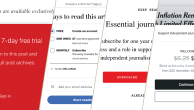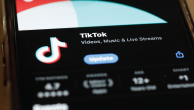The sites in the study fell into four basic types. One consisted of sites that were organized into groups or families. These tended to share a common name and have a single primary parent organization. The study found two such groups: The Watchdog.org sites and the American Independent News Network. The second type of news site was a looser consortium of sites that shared content but not necessarily the same parent. The study found one such group, the Statehouse News sites. A third type of site consisted of those that operated wholly independently and draw funding from a variety of private foundations (we call this group the “individual multi-funder”). Finally, the study identified a collection of sites that fit the criteria of study in every way except they were commercial in nature in that they relied on advertising for their chief source of revenue and were designated as for-profit companies (usually limited liability companies). As a basis of comparison, they were included in the study as well.
The Watchdog.org sites are widespread, with either a presence, or the groundwork for a future presence, in every state. They are sponsored by the Franklin Center for Government & Public Integrity, though a number of sites draw support from other think tanks as well. Though it is not disclosed on its own site, The Franklin Center itself was launched with the help of the Sam Adams Alliance, which says little about its own motivations, though press releases archived on its website include the sentence that the group seeks to “increase public awareness of free-market principles and policies.”
[1]
[2]
[3]
Among the key findings on the Watchdog.org family:
- The sites scored a 63 on the 100-point scale PEJ devised to measure ideology, making its journalism the second-most ideologically oriented in the study.
- 41% of stories presented a primarily conservative theme, while 11% contained pro-liberal themes. (49% contained no particular theme or a mixture.)
- On nine of the sites, only Democrats or government agencies were the subject of investigative exposes.
- The majority of Watchdog stories (53%) contained only one-or mostly one-point of view. About one third (34%) contained two or more.
- The sites scored 61 on a 100-point transparency scale, ranking them among the least transparent of all sites studied.
- The sites as a whole scored 20 on a 100-point scale for productivity, which measures volume of original reporting and opinion blogging, as well as the number of editorial and reporting staff listed. As a group, they were the lowest in productivity.
Not all Watchdog.org sites fit the group pattern. The Virginia Watchdog, for instance, scored a 30 on the ideology scale, half of the average. Two others, Nebraska Watchdog (35) and New Mexico Watchdog (40) also scored on the lower end of the ideology scale as well.
American Independent News Network
[6]
The sites themselves have a uniform design and receive their funding through the American Independent News Network, known previously as the Center for Independent media, whose goals are explicitly liberal in nature. According to the parent group’s website, “Our reporting emphasizes the positive role of democratically elected government in securing the common good and social welfare, and the continuing benefits of our founding culture of egalitarian government by the people, for the people.”
A tightly knit network, the American Independent sites syndicate their stories, sharing them among their partners. For example, a Sept. 16 piece by Andy Kopsa entitled “Federal faith-based grant agency lacks oversight, transparency” was carried by The New Mexico Independent, The Iowa Independent and The Washington Independent. A Sept. 13 article by Andrew Restuccia, “Gulf Coast Residents in Financial Dire Straits, Waiting for BP Claims,” was carried in both The Florida Independent and the Washington Independent. A Sept. 14 story entitled “Who Would the Tax Increases Hurt?” by Anne Lowery ran in The Washington Independent, The Michigan Messenger and The Minnesota Independent.
The American Independent News Network is funded by a variety of foundations and individual donors, among them the James S. and John L. Knight Foundation, Open Society Foundations and the Tides Foundation (Open Society Foundations is not currently funding the American Independent News Network).
According to the study results:
- American Independent network scored a 64 on the 100-point ideology scale, similar to the Watchdog sites (63).
- In the time period studied, 37% of stories carried a pro-liberal theme, while 11% were pro-conservative.
- On six out of the nine sites, only Republicans or businesses were the subject of investigative exposes.
- The group offered the narrowest range of viewpoints in its reporting in the study. Across the group, 59% of stories contained only or mostly one point of view, while 28% contained two or more points of view.
- The American Independent News sites as a group scored 72 on the 100 point scale for transparency, making them more transparent than the Watchdog.org sites but less transparent than the individual multi-funder sites.
- The American Independent News sites scored a 49 on the productivity scale-placing the sites on average in the middle of the pack when it came to volume of reporting and staff size.
As with Watchdog.org sites, not every member of the family fit the pattern. The Florida Independent, for instance, scored a 40 on the ideology scale-50% lower than the group average and lower than many other sites in the study.
Statehouse News Online is a website and aggregator launched in fall 2010 by the Franklin Center. According to a press release, “News from MarylandReporter.com, Virginia Statehouse News, Illinois Statehouse News, the Nevada News Bureau and other online news operations that were established with the Franklin Center’s help will be posted on the site every day.”
The site does not provide a list of the sites that belong to the consortium or specific criteria that might put one on the list. Many seem to be tied in some way to the Franklin Center, though the ties vary, and not all sites mention the Franklin Center directly.
Most of the sites that belong to Statehouse News Online are each supported by think tanks which belong to yet another group-the State Policy Network (two exceptions are Tennessee Report and Missouri News Horizon, which do not identify their source of funding). The State Policy Network is a group “dedicated solely to improving the practical effectiveness of independent, non-profit, market-oriented, state-focused think tanks.” The group calls itself a capacity builder, organizing free-market think tanks around the country. Many of those think tanks have produced online news outlets-news outlets that make up the membership of Statehouse News Online.
Among the findings of the quantitative study:
- The Statehouse sites on average scored relatively low on the ideology sale (together, 33 out of 100). Some sites, like Illinois Statehouse News (which scored a 0) and Colorado News Agency (15) produced little ideologically oriented content during the time period studied. Others, such as Idaho Reporter (70 on the ideology scale), consistently presented news through a free-market and conservative lens.
- Together, the sites’ content offered pro-conservative ideas 23% of the time and pro-liberal themes 13%, with the majority of content studied (54%) containing no dominant theme at all.
- Little of the Statehouse News site content studied (11%) consisted of investigative pieces targeting wrongdoers. Of those targeted pieces, there was no discernable ideological pattern.
- The Statehouse News sites were more diverse thanthe two major families of sites in their representation of viewpoints. About half of the stories studied in this group (50%) represented only one viewpoint, while 35% of the stories contained two points of view.
- The Statehouse News consortium as a whole contained some of the least transparent sites in the study. Together they scored 58 on the 100-point transparency scale, lower than either the Watchdog.org sites or the American Independent News sites.
- The sites as a group were somewhat moreproductive, scoring 33, than the Watchdog.org sites (20) but less so than the American Independent News Network (49).
Individual Multi-Funder Sites
Five sites in the study fell into a category of being independent, non-profit sites with multiple funders. In general, these sites were underwritten by a handful of charitable foundations. Some of these foundations are widely recognized for their work in promoting journalism, such as the John S. and James L. Knight Foundation and the John D. & Catherine T. MacArthur Foundation. Of the five sites studied here, the Knight Foundation was listed as a supporter for each one.
The sites themselves tended to be among the most ambitious in their goals and have the financial backing to make them serious entrants into the changing news ecosystem.
Two of the more ambitious of these sites are ProPublica and Texas Tribune. ProPublica, launched in 2008 by former Wall Street Journal managing editor Paul Steiger and with a major financial commitment by the Sandler Foundation, operates on a nearly $10 million budget. Its sizable reporting staff of 34 (a current figure, published by the website since PEJ’s audit was conducted) won a Pulitzer Prize in 2010 for their reporting on Hurricane Katrina and another in 2011 for their reporting on questionable Wall Street practices.
The study’s site audit and content analysis revealed that ProPublica was among the most mixed or balanced in the focus of its coverage and the targets of its exposes. It also made substantial effort to be transparent about its operations. In 2010, ProPublica published on its site a tax form revealing the salaries of its news and executive staff. It is also explicit about its mission and who its funders are. One noticeable omission is detailed information about the Sandler Foundation, which does not provide a website.
The Texas Tribune was launched in 2009 in part by Austin venture capitalist John Thornton, formerly a well-known donor to Democratic candidates and causes. The Tribune aims to be a “nonpartisan, nonprofit media organization that promotes civic engagement and discourse on public policy, politics, government, and other matters of statewide concern.”
As it develops its several revenue streams, the site aims to break even on $3 million in revenue by 2013.
Other sites in this category include MinnPost, California Watch and CT Mirror. In general, each of these can boast the same high level of neutral reporting, transparent operations and a robust staffing operation, though MinnPost and California Watch tended to lean slightly leftward in the ideological tone of the stories that were studied by PEJ.
Commercial Sites
Seven of the sites in the study fit all of the criteria (new, statewide, general interest news, relatively productive) but were organized as for-profit enterprises. As a group, the sites derive much of their revenue from advertising. Like all the other sites in the study, however, these organizations were organized to fill a void in the current journalistic landscape by providing original reporting on state and national public affairs issues on the web.
If these sites have anything in common, it is that they tend to produce more original content on a weekly basis than most other sites in the study. But they vary widely when it comes to the question of whether the coverage reflects an ideological orientation. The Daily Caller, for instance, run by cable news pundit Tucker Carlson, scored a 70 on the 100-point ideology scale (higher than all but four sites in the study). Another site, Progress Illinois-the voice of organized labor in that state, and as liberal in its content as The Daily Caller is conservative-scored a 65 on the ideology scale.
Yet others, such as the Alaska Dispatch, presented a much more balanced approach. The Dispatch made national news when one of its reporters was roughed up by one of Senate candidate Joe Miller’s staff members during the 2010 mid-term elections. The site scored a 25 on the ideology scale, one of the lowest or most balanced in the study. Another site, founded by a number of former Star Ledger employees, is New Jersey Newsroom. It scored only 15 in terms of ideology, lower than all but four sites in the study.
The commercial sites also varied widely in their level of transparency. New West and Alaska Dispatch, for instance, disclosed a great deal of information about their agenda and their investors. Sunshine State News, by contrast, scored a low 40 on the transparency scale, which ranked it less transparent than all but two sites in the entire study.
Many of the commercial sites produce more content than most of the other sites studied. Two of the most productive sites were Alaska Dispatch (93 out of 100 on the scale) and The Daily Caller (100). The Alaska Dispatch averaged 21 stories per week during the time period studied, averaged 3-5 additional blog posts per week, and maintained an editorial and reporting staff of about 15. The Daily Caller averaged 49 stories per week during the period of study, a greater volume of content than all but one other site. Its bloggers churned out additional entries at least daily. (Its staff size was unavailable).
Outlier Sites
Two other sites fit all the criteria for inclusion in the study, yet did not fall naturally into any of the various types or categories. They did not belong to any of the families or networks of sites. Yet while they were independent, they differed from the individual multi-funder sites because they drew funding from a limited pool of sponsors.
One of these, Cal Watchdog, is a non-profit outlet that derives funding from a think tank called the Pacific Research Institute, which works to advance free-market policy solutions. Cal Watchdog scored 80 on the 100-point transparency scale-clear in its statement of mission and purpose, but less forthright when it came to its ultimate funding sources. With its editorial staff of four and an average of seven stories per week plus a relatively robust blogging operation, Cal Watchdog scored 40 on the productivity scale-placing it right around the middle of the pack.
NJ Spotlight is a non-profit outlet supported by three foundations, including the Knight Foundation. Though the site was brief in its description of its mission, it was somewhat easier to trace the money trail from New Jersey Spotlight to its major donors and the wealth behind those donors. It scored 80 on the transparency scale. When it came to productivity, the site scored 43. It listed four editorial staff, produced on average 14 stories per week and produced content for an additional opinion platform on its site.
Neither of the two sites produced enough content during the sample period to depict, with a suitable degree of methodological soundness, their ideological scores.
[1]
[2]
[3]
[4]
[5]
[6]




